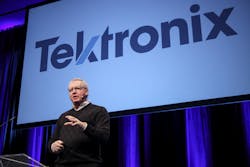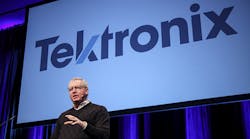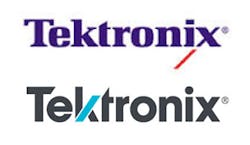Q&A: Tektronix CEO Pat Byrne on New Application Focus
Having being involved in a number of branding– and rebranding–cycles, I know how hard it can be. You want to make the right choice so that your customers still trust you, your internal team is behind you, and Wall Street believes in you. If you come up short on any of those, you’re in for a world of hurt.
So why did Tektronix open Pandora’s box and undergo a bit of a rebranding exercise, including a snazzy new logo it showed to all this week? Tektronix CEO Pat Byrne sat down with me to talk about it.
Or maybe he stood. Standing is the “in” thing now, so maybe everyone at Tek’ is standing instead of sitting. It was a telephone call, so I couldn’t tell.
He might well have been standing, because he answered really well when I asked him why he modified the logo that has stood for reliability, dependability, innovation, and performance for 24 of the company’s 70 years.
“We’re still very strong in those areas, but we've updated the visual identity with how we see the evolution of the company from a product-centric hardware company to an application-focused technology company,” he said. “This is a high-technology company, and we serve some of the fastest-moving companies in the world, and we thought updating it was smart to do to signify the continued evolution of the company.”
Fair enough, but what does that actually mean? We have design cycles in which test time is looming larger and larger as a slice of the time-to-market pie chart, along with software development. It’s not that test tools and equipment have gotten slower; if anything, they’ve gotten faster with more features–and more complexity.
It’s simply that design cycles have gone from years to months, following the consumer cycle instead of industrial or automotive cycle, and test equipment is not a “consumable.” Also, with complexity of test, comes a learning curve that must be accelerated.
So, I asked Byrne what an “application-focused technology company” could actually do to speed test and measurement. I also asked him what was meant by “shift left,”a change in thinking required by both test companies and designers that he mentioned at the recent DesignCon event, and here’s what he said. (You can listen to the interview by clicking on the embedded image below, or you can skim the highlights below and jump to that section in the recording where I provided time stamps.)
So what does this mean for you? Well, the way Byrne put it, designers are integrating technology from various disciplines, such as Wi-Fi radios and computer boards, all from different suppliers.
“But to test that, you have to have test technology that’s now operating at that sort of application layer,” said Byrne. “We've [note the emphasis] added the value in software and the integration of these products working together, so you can get a sophisticated test system up and running, do the tasks, and really move the product development to the next phase, whether that be getting it ready for production or working with a partner and enabling how their business works.”
Here are some more highlights from our conversation with Pat Byrne:
ED: You discussed "shifting left" at DesignCon recently, what does that mean and does it differ from DFT? [3:00 minutes]
Byrne: DFT is for manufacturing test strategies: you design capability into the final product so that it’s more easily tested. In shift left, it’s the same thing, except it’s for the development phase. Now, before people build a product, they simulate it to see how all the parts work together.
That way they can do many iterations, they don’t have to build a prototype and they can really try out different things in a virtual world. There’s a whole development cycle with sophisticated electronic design automation, or EDA tools.
So, shift left is integrating test tools with those simulation tools. And our customers are saying there’s a lot of value in the testing phase because we know so much about these applications… We know a lot about them in the physical world, and can we bring some of that know-how into the virtual world?
ED: So that’s a shift in thinking, too, for engineers: putting test further up in the design and prototyping cycle? [5:21]
Byrne: That’s right, and the most sophisticated teams are the ones that are thinking about shifting design cycles, they are in fact using more sophisticated building blocks to build their systems, but they’re really integrating their work flow, and interacting these tools and processes to have a better transition—and, frankly, get all the benefits.
An example is next-generation automotive electronics where the cellphone and entertainment system will be vitally integrated together. We focus on the applications that help the person designing the electronics in that car achieve all that compliance and interoperability so they can bring that solution to market quickly.
Another example is Nest thermostats, where the designers are more likely to be UI designers or digital designers. So if we can design a spectrum analyzer or something that analyzes an RF signal, in an easy-to-use application-focused way, they’ll be far more effective in creating wireless connectivity in the latest consumer device.
[7:56] Byrne elaborates more on the software and hardware integration and interoperability between components and modules, but the point is clear: It’s all about being at the nexus between component integration and application software. What a system does, and how it can do it better and with fewer hiccups along the way.
[9:02] Byrne is under no illusions: To make this happen will require collaboration across industry, with new chip technologies, workflows, and commitment to “the kind of precision and accuracy that makes test and measurement the foundation for high-quality system design.”
It will also require a bit of rethinking on the part of the engineers, researchers, and designers. “How you think about probing circuits, how you think about software working together, about systems coming together, I think engineers need to think about it as it’s not just a design flow but also as an integration challenge. We’re focused on that, and we think our customers will be very interested in working with us on that.”
Changing a Logo
How many people does it take to change a logo? Thousands. As mentioned above, changing anything to do with a brand isn’t easy. In Tektronix’s case, it took input from thousands of customers and staff, globally, to first get the game plan in place, and then the logo. Here’s the description of its styling, per the company’s press release:
“The legacy Tektronix logo has been refashioned, with the angle incorporated within the logotype as an upwards gesture of progress. The sans-serif type is given character by subtly clipping the ‘T’ letterforms, echoing the blue angle. Simple, definitive lines reflect our promise of performance.”
So, there you have it. I like the new look. I also think Tektronix is dead on in what it’s aiming to do and I’m really looking forward to seeing what technologies and tools come out of this “shift left.” They’re badly needed, and Tektronix isn’t the only company seeing this need.
About the Author
Patrick Mannion Blog
Founder and Managing Director
Patrick Mannion is Founder and Managing Director of ClariTek, LLC, a high-tech editorial services company. After graduating with a National Diploma in Electronic Engineering from the Dundalk Institute of Technology, he worked for three years in the industry before starting a career in b2b media and events. He has been covering the engineering, technology, design, and the electronics industry for 25 years. His various roles included Components and Communications Editor at Electronic Design and more recently Brand Director for UBM's Electronics media, including EDN, EETimes, Embedded.com, and TechOnline.


